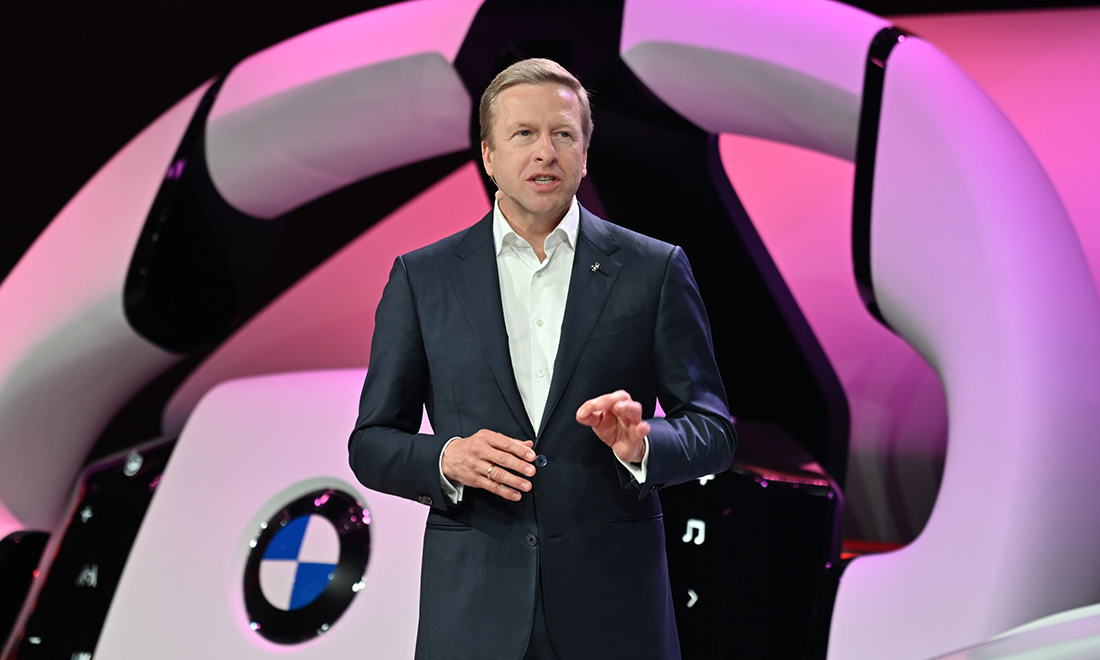
? 寶馬公司首席執(zhí)行官奧利弗·齊普策(Oliver Zipse)認(rèn)為,,盡管他正準(zhǔn)備推出首款基于全新純電動(dòng)汽車(chē)專(zhuān)屬平臺(tái)的車(chē)型(后續(xù)還將推出數(shù)款),但寶馬此前不愿跟風(fēng)投身電動(dòng)汽車(chē)領(lǐng)域的決策已得到驗(yàn)證,?!凹幢忝媾R巨大阻力,我們?nèi)詧?jiān)定立場(chǎng),。如今形勢(shì)正朝著有利于我們的方向發(fā)展,?!彼f(shuō)道,。
市場(chǎng)研究公司Gartner將這一階段稱(chēng)為“幻滅低谷”:一項(xiàng)熱門(mén)新技術(shù)首次未能達(dá)到其炒作效果時(shí)所處的階段。
寶馬是最早預(yù)測(cè)電動(dòng)車(chē)將經(jīng)歷發(fā)展陣痛的車(chē)企之一,。多年來(lái),,這家德國(guó)豪華汽車(chē)制造商的高管一直警告稱(chēng),盡管特斯拉掀起了行業(yè)熱潮,,但購(gòu)車(chē)者轉(zhuǎn)向電動(dòng)車(chē)的速度不會(huì)如預(yù)期般迅速,。
如今,寶馬向股東表態(tài),,將堅(jiān)守多元化動(dòng)力系統(tǒng)戰(zhàn)略,,持續(xù)為消費(fèi)者提供包括燃油車(chē)、混合動(dòng)力車(chē)型以及2028年將首次亮相的氫燃料電池車(chē)在內(nèi)的產(chǎn)品選擇,。
首席執(zhí)行官奧利弗·齊普策在上周三舉行的寶馬年會(huì)上說(shuō):“技術(shù)開(kāi)放意味著緊跟市場(chǎng),,因?yàn)槭袌?chǎng)在演變,但不同市場(chǎng)的發(fā)展步調(diào)并不一致,。將電動(dòng)化作為唯一技術(shù)路徑只會(huì)走向死胡同,。當(dāng)前形勢(shì)已充分表明了這一點(diǎn),。”
大約五年前,,包括梅賽德斯-奔馳(Mercedes-Benz),、大眾(Volkswagen)和沃爾沃(Volvo)在內(nèi)的許多品牌均宣布了盡快向電動(dòng)車(chē)轉(zhuǎn)型的宏大目標(biāo)。相比之下,,寶馬拒絕跟風(fēng)電動(dòng)車(chē)?yán)顺?,曾招致大眾前首席?zhí)行官赫伯特·迪斯(Herbert Diess)等競(jìng)爭(zhēng)對(duì)手批評(píng)其拖慢行業(yè)進(jìn)程。
齊普策表示:“即便面臨巨大阻力,,我們?nèi)詧?jiān)定立場(chǎng),。如今形勢(shì)正朝著有利于我們的方向發(fā)展?!?/p>
2013年,,寶馬推出了適用于市內(nèi)駕駛的小型電動(dòng)車(chē)i3,但這款車(chē)型卻讓公司蒙受損失,。該車(chē)型采用輕量化但成本高昂的碳纖維車(chē)身架構(gòu),,本欲成為潮流標(biāo)桿,卻淪為分析師與投資者眼中的財(cái)務(wù)失敗案例,。
傳統(tǒng)品牌難以說(shuō)服消費(fèi)者接受電動(dòng)車(chē)優(yōu)勢(shì)
在本十年初,,隨著特斯拉風(fēng)靡全球,首席執(zhí)行官埃隆·馬斯克(Elon Musk)忙于應(yīng)對(duì)旺盛需求,,這種電動(dòng)車(chē)的宣傳熱潮看似合乎產(chǎn)業(yè)邏輯,。2020年,特斯拉雖全年僅售出50萬(wàn)輛汽車(chē),,卻超越所有汽車(chē)同行,,成為全球市值最高的車(chē)企。
寶馬的競(jìng)爭(zhēng)對(duì)手已投入數(shù)十億美元開(kāi)發(fā)專(zhuān)用架構(gòu),,以經(jīng)濟(jì)高效地制造各種尺寸和類(lèi)型的電動(dòng)汽車(chē),,如梅賽德斯-奔馳的EVA2和大眾備受推崇的MEB平臺(tái)。
但現(xiàn)實(shí)卻給行業(yè)潑了一盆冷水,。傳統(tǒng)品牌難以向持懷疑態(tài)度的消費(fèi)者闡述技術(shù)優(yōu)勢(shì),。車(chē)企抱怨稱(chēng),圍繞電動(dòng)車(chē)仍有許多認(rèn)知誤區(qū)待澄清,,包括車(chē)主在雨中充電是否會(huì)觸電,。
相比之下,特斯拉能夠迎合那些渴望率先體驗(yàn)最新技術(shù),、熟知產(chǎn)品利弊的前衛(wèi)受眾,。
如今,許多傳統(tǒng)車(chē)企如梅賽德斯-奔馳和沃爾沃已著手調(diào)整激進(jìn)的電動(dòng)車(chē)銷(xiāo)售目標(biāo)。
新款iX3將于年底投產(chǎn)
電動(dòng)車(chē)普及速度低于預(yù)期,,特斯拉也未能幸免,。去年,特斯拉放棄了2030年的銷(xiāo)售目標(biāo),,遭遇Model Y推出以來(lái)的首次年度銷(xiāo)量下滑,,且頹勢(shì)持續(xù)到今年第一季度。
其一,,在全球最大的電動(dòng)車(chē)市場(chǎng)中國(guó),,這些品牌原本期望將其在傳統(tǒng)燃油車(chē)市場(chǎng)的份額轉(zhuǎn)移至電動(dòng)車(chē)領(lǐng)域。就連特斯拉也從2024年的第三位跌至上個(gè)月的第八位,。
其他國(guó)家,,如美國(guó),根本不愿再用每輛車(chē)7500美元的聯(lián)邦稅收補(bǔ)貼來(lái)資助購(gòu)買(mǎi)更昂貴的電動(dòng)汽車(chē),。歐洲市場(chǎng)對(duì)電動(dòng)汽車(chē)的興趣也不盡相同,。
在石油資源豐富的挪威,幾乎沒(méi)有新車(chē)仍使用汽油或柴油,,而在歐元區(qū)第三大經(jīng)濟(jì)體意大利,,去年電動(dòng)車(chē)在新車(chē)市場(chǎng)的份額僅為4%。
齊普策表示:“差異過(guò)于顯著,,甚至在歐洲內(nèi)部亦是如此,。”寶馬集團(tuán)(包括寶馬,、迷你和勞斯萊斯品牌)的全球電動(dòng)車(chē)銷(xiāo)量增長(zhǎng)了14%,,至超42.65萬(wàn)輛。
然而,,就連這家慕尼黑汽車(chē)制造商也放棄了對(duì)電動(dòng)專(zhuān)屬平臺(tái)的抵觸——計(jì)劃于今年年底在匈牙利投產(chǎn)的寶馬iX3中型電動(dòng)跨界車(chē)將基于全新純電架構(gòu)Neue Klasse打造,。(財(cái)富中文網(wǎng))
譯者:中慧言-王芳
? 寶馬公司首席執(zhí)行官奧利弗·齊普策(Oliver Zipse)認(rèn)為,盡管他正準(zhǔn)備推出首款基于全新純電動(dòng)汽車(chē)專(zhuān)屬平臺(tái)的車(chē)型(后續(xù)還將推出數(shù)款),,但寶馬此前不愿跟風(fēng)投身電動(dòng)汽車(chē)領(lǐng)域的決策已得到驗(yàn)證,?!凹幢忝媾R巨大阻力,,我們?nèi)詧?jiān)定立場(chǎng)。如今形勢(shì)正朝著有利于我們的方向發(fā)展,?!彼f(shuō)道。
市場(chǎng)研究公司Gartner將這一階段稱(chēng)為“幻滅低谷”:一項(xiàng)熱門(mén)新技術(shù)首次未能達(dá)到其炒作效果時(shí)所處的階段,。
寶馬是最早預(yù)測(cè)電動(dòng)車(chē)將經(jīng)歷發(fā)展陣痛的車(chē)企之一,。多年來(lái),這家德國(guó)豪華汽車(chē)制造商的高管一直警告稱(chēng),盡管特斯拉掀起了行業(yè)熱潮,,但購(gòu)車(chē)者轉(zhuǎn)向電動(dòng)車(chē)的速度不會(huì)如預(yù)期般迅速,。
如今,寶馬向股東表態(tài),,將堅(jiān)守多元化動(dòng)力系統(tǒng)戰(zhàn)略,,持續(xù)為消費(fèi)者提供包括燃油車(chē)、混合動(dòng)力車(chē)型以及2028年將首次亮相的氫燃料電池車(chē)在內(nèi)的產(chǎn)品選擇,。
首席執(zhí)行官奧利弗·齊普策在上周三舉行的寶馬年會(huì)上說(shuō):“技術(shù)開(kāi)放意味著緊跟市場(chǎng),,因?yàn)槭袌?chǎng)在演變,但不同市場(chǎng)的發(fā)展步調(diào)并不一致,。將電動(dòng)化作為唯一技術(shù)路徑只會(huì)走向死胡同,。當(dāng)前形勢(shì)已充分表明了這一點(diǎn)?!?/p>
大約五年前,,包括梅賽德斯-奔馳(Mercedes-Benz)、大眾(Volkswagen)和沃爾沃(Volvo)在內(nèi)的許多品牌均宣布了盡快向電動(dòng)車(chē)轉(zhuǎn)型的宏大目標(biāo),。相比之下,,寶馬拒絕跟風(fēng)電動(dòng)車(chē)?yán)顺保兄麓蟊娗笆紫瘓?zhí)行官赫伯特·迪斯(Herbert Diess)等競(jìng)爭(zhēng)對(duì)手批評(píng)其拖慢行業(yè)進(jìn)程,。
齊普策表示:“即便面臨巨大阻力,,我們?nèi)詧?jiān)定立場(chǎng)。如今形勢(shì)正朝著有利于我們的方向發(fā)展,?!?/p>
2013年,寶馬推出了適用于市內(nèi)駕駛的小型電動(dòng)車(chē)i3,,但這款車(chē)型卻讓公司蒙受損失,。該車(chē)型采用輕量化但成本高昂的碳纖維車(chē)身架構(gòu),本欲成為潮流標(biāo)桿,,卻淪為分析師與投資者眼中的財(cái)務(wù)失敗案例,。
傳統(tǒng)品牌難以說(shuō)服消費(fèi)者接受電動(dòng)車(chē)優(yōu)勢(shì)
在本十年初,隨著特斯拉風(fēng)靡全球,,首席執(zhí)行官埃隆·馬斯克(Elon Musk)忙于應(yīng)對(duì)旺盛需求,,這種電動(dòng)車(chē)的宣傳熱潮看似合乎產(chǎn)業(yè)邏輯。2020年,,特斯拉雖全年僅售出50萬(wàn)輛汽車(chē),,卻超越所有汽車(chē)同行,成為全球市值最高的車(chē)企,。
寶馬的競(jìng)爭(zhēng)對(duì)手已投入數(shù)十億美元開(kāi)發(fā)專(zhuān)用架構(gòu),,以經(jīng)濟(jì)高效地制造各種尺寸和類(lèi)型的電動(dòng)汽車(chē),,如梅賽德斯-奔馳的EVA2和大眾備受推崇的MEB平臺(tái)。
但現(xiàn)實(shí)卻給行業(yè)潑了一盆冷水,。傳統(tǒng)品牌難以向持懷疑態(tài)度的消費(fèi)者闡述技術(shù)優(yōu)勢(shì),。車(chē)企抱怨稱(chēng),圍繞電動(dòng)車(chē)仍有許多認(rèn)知誤區(qū)待澄清,,包括車(chē)主在雨中充電是否會(huì)觸電,。
相比之下,特斯拉能夠迎合那些渴望率先體驗(yàn)最新技術(shù),、熟知產(chǎn)品利弊的前衛(wèi)受眾,。
如今,許多傳統(tǒng)車(chē)企如梅賽德斯-奔馳和沃爾沃已著手調(diào)整激進(jìn)的電動(dòng)車(chē)銷(xiāo)售目標(biāo),。
新款iX3將于年底投產(chǎn)
電動(dòng)車(chē)普及速度低于預(yù)期,,特斯拉也未能幸免。去年,,特斯拉放棄了2030年的銷(xiāo)售目標(biāo),,遭遇Model Y推出以來(lái)的首次年度銷(xiāo)量下滑,且頹勢(shì)持續(xù)到今年第一季度,。
其一,,在全球最大的電動(dòng)車(chē)市場(chǎng)中國(guó),這些品牌原本期望將其在傳統(tǒng)燃油車(chē)市場(chǎng)的份額轉(zhuǎn)移至電動(dòng)車(chē)領(lǐng)域,。就連特斯拉也從2024年的第三位跌至上個(gè)月的第八位,。
其他國(guó)家,如美國(guó),,根本不愿再用每輛車(chē)7500美元的聯(lián)邦稅收補(bǔ)貼來(lái)資助購(gòu)買(mǎi)更昂貴的電動(dòng)汽車(chē),。歐洲市場(chǎng)對(duì)電動(dòng)汽車(chē)的興趣也不盡相同。
在石油資源豐富的挪威,,幾乎沒(méi)有新車(chē)仍使用汽油或柴油,,而在歐元區(qū)第三大經(jīng)濟(jì)體意大利,去年電動(dòng)車(chē)在新車(chē)市場(chǎng)的份額僅為4%,。
齊普策表示:“差異過(guò)于顯著,,甚至在歐洲內(nèi)部亦是如此?!睂汃R集團(tuán)(包括寶馬,、迷你和勞斯萊斯品牌)的全球電動(dòng)車(chē)銷(xiāo)量增長(zhǎng)了14%,至超42.65萬(wàn)輛,。
然而,,就連這家慕尼黑汽車(chē)制造商也放棄了對(duì)電動(dòng)專(zhuān)屬平臺(tái)的抵觸——計(jì)劃于今年年底在匈牙利投產(chǎn)的寶馬iX3中型電動(dòng)跨界車(chē)將基于全新純電架構(gòu)Neue Klasse打造。(財(cái)富中文網(wǎng))
譯者:中慧言-王芳
? BMW’s chief executive Oliver Zipse felt his company’s reluctance to jump on the EV bandwagon has been vindicated even as he prepares to launch his first of several models underpinned by an platform built from the ground up for EVs. “We took a clear stand on this, even in the face of strong headwinds. Now the wind has shifted in our direction,” he said.
Market research firm Gartner dubbed it the “trough of disillusionment”: the stage when a buzzy new technology first fails to live up to its hype.
One of the earliest to predict electric vehicles would suffer its own growing pains has been BMW. For years, executives at the German premium carmaker have been warning car buyers would not make the switch as quickly as anticipated, despite all the excitement around Tesla.
Now, it’s told shareholders it would stand by its commitment to offer customers a wide range of drivetrain options including combustion engine, hybrid, and even hydrogen fuel-cell powered cars, with the latter debuting in 2028.
“Technology openness means following the markets, because markets evolve, but not all a the same pace,” said CEO Oliver Zipse at BMW’s annual meeting on Wednesday. “E-mobility as the sole technology leads to a dead end. That should be obvious by now.”
Some five years ago, a number of brands including Mercedes-Benz, Volkswagen, and Volvo proclaimed ambitious targets for how soon they would switch to EVs. By comparison, BMW’s reluctance to jump on the EV bandwagon saw rivals like VW’s ex-CEO Herbert Diess criticize the company for slowing down progress.
“We took a clear stand on this, even in the face of strong headwinds. Now the wind has shifted in our direction,” Zipse continued.
BMW turned bearish on EVs after the company was burned by the i3, a small EV for inner-city driving that launched in 2013. Featuring a lightweight but expensive carbon-fibre body, it was supposed to be a trend setter, but ended up a financial failure in the eyes of analysts and investors.
Legacy brands struggled to convince their customer base of the advantages of EVs
At the start of the decade, this EV evangelizing seemed to make sense as Tesla was all the rage and CEO Elon Musk struggled to keep up with demand. In 2020, Tesla eclipsed all automotive peers to become the most valuable carmaker in the world despite selling only half a million vehicles that year.
BMW’s rivals had already poured billions into the development of dedicated architectures capable of economically building a wide variety of EVs in all shapes and sizes—such as the EVA2 at Mercedes-Benz and Volkswagen’s vaunted MEB platform.
The results have been sobering. Legacy brands have had a difficult time explaining the advantages of the technology to their skeptical customers. Carmakers have complained there are still plenty of popular myths around EVs that need to be debunked, including whether owners might be electrocuted while charging in the rain.
By comparison, Tesla could cater to a predominantly progressive audience eager to be the first to test out the latest that technology had to offer, and were well-versed about the various pros and cons.
Now, many of these same legacy companies such as Mercedes and Volvo have been walking back their more ambitious EV sales targets.
Start of production of new iX3 at year-end
The slower-than-expected uptake in EVs hasn’t left Tesla untouched either. Last year, it buried its own 2030 sales target, suffered its first annual sales decline since the Model Y launched, and saw its slump continue into the first quarter.
For one, the Chinese EV market, which is the world’s largest, is increasingly shutting out western brands that had expected to transfer their market share in the traditional combustion-engine market to the EV market. Even Tesla dropped to eighth place last month, from third in 2024.
Other countries like the United States are flat-out no longer willing to finance the purchase of a more expensive EV with a $7,500 per car federal tax subsidy. Europe also has experienced disparate levels of interest.
While few new cars sold in oil-rich Norway still require gasoline or diesel, in the euro area’s third-largest economy, Italy, the EV share of the new-car market languished at just 4% last year.
“The differences are too severe, even within Europe,” Zipse said, whose company’s own global EV sales grew by 14% to over 426,500 vehicles across the BMW, Mini, and Rolls-Royce brands.
Nevertheless, even the Munich carmaker has dropped its opposition to dedicated EV platforms. The BMW iX3 mid-size electric crossover, scheduled to go into production at the end of this year in Hungary, is based on the Neue Klasse, an all-new and EV-only architecture.






